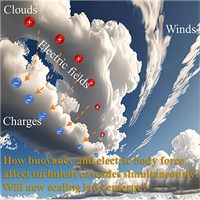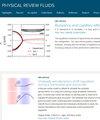Cascades of turbulent kinetic energy and multicomponent scalars in a momentum-scalar coupling turbulence driven by multiple mechanisms under homogeneous and isotropic hypotheses
IF 2.5
3区 物理与天体物理
Q2 PHYSICS, FLUIDS & PLASMAS
引用次数: 0
Abstract
Momentum-scalar coupling turbulence, a phenomenon observed in both natural and engineering contexts, involves the intricate interaction between multicomponent scalars and multiscale forces (i.e., multiple coupling mechanisms), resulting in a wide array of manifestations. Despite its importance, limited research has been conducted to comprehend the influence of these multicomponent and multiple coupling mechanisms on turbulence cascades. Hence, this study aims to provide a preliminary and theoretical exploration into how these multiple coupling mechanisms govern the cascades of turbulent kinetic energy and multicomponent scalars. To simplify the mathematical analysis, homogeneous and isotropic hypotheses of flow field have been applied. The key findings of this study can be summarized as follows. The first is validation of quad-cascade processes. The second is an examination of various cases involving single scalar components but multiple coupling mechanisms. Of particular interest is the coexistence of buoyancy-driven turbulence and electrokinetic turbulence, which introduces a new variable flux (VF) subrange resulting from their nonlinear interaction. Another extension considers an exponential modulation function, equivalent to the coexistence of multiple coupling mechanisms acting on a single scalar. The study identifies two new VF subranges. Third, binary scalar components and coupling mechanisms are investigated, indicating coupling mechanisms with significantly different strengths that can also induce complex interactions and new VF subranges. Fourth is the complexity when three or more different scalar components and coupling mechanisms coexist simultaneously: with the exception of certain special cases, closure of the problem becomes unattainable. This highlights the challenges inherent in addressing the simultaneous presence of multiple scalar components and coupling mechanisms. This research endeavor illuminates the theoretical understanding of the diverse scaling properties observed in momentum-scalar coupling turbulence across different scenarios.

均质和各向同性假设下多种机制驱动的动量-标量耦合湍流中的湍流动能和多分量标量级联
动量-标量耦合湍流是一种在自然和工程环境中都能观察到的现象,涉及多分量标量和多尺度力(即多重耦合机制)之间错综复杂的相互作用,从而导致一系列广泛的表现形式。尽管湍流级联非常重要,但在理解这些多组分和多重耦合机制对湍流级联的影响方面的研究还很有限。因此,本研究旨在从理论上初步探讨这些多重耦合机制如何影响湍流动能和多组分标量的级联。为了简化数学分析,本研究采用了流场的均质和各向同性假设。本研究的主要结论可归纳如下。首先是对四级联过程的验证。其次是对涉及单一标量成分但有多种耦合机制的各种情况进行了研究。特别值得关注的是浮力驱动湍流和电动湍流的共存,这引入了一个由它们的非线性相互作用产生的新的可变通量(VF)子范围。另一个扩展考虑了指数调制函数,相当于作用于单个标量的多种耦合机制并存。研究确定了两个新的 VF 子范围。第三,研究了二元标量成分和耦合机制,表明耦合机制的强度存在显著差异,也会诱发复杂的相互作用和新的 VF 子区间。第四,当三个或更多不同的标量成分和耦合机制同时存在时,问题就变得复杂了:除了某些特殊情况,问题的封闭性变得无法实现。这凸显了解决同时存在多个标量成分和耦合机制问题所固有的挑战。这项研究工作阐明了对动量-标量耦合湍流在不同情况下观察到的不同缩放特性的理论理解。
本文章由计算机程序翻译,如有差异,请以英文原文为准。
求助全文
约1分钟内获得全文
求助全文
来源期刊

Physical Review Fluids
Chemical Engineering-Fluid Flow and Transfer Processes
CiteScore
5.10
自引率
11.10%
发文量
488
期刊介绍:
Physical Review Fluids is APS’s newest online-only journal dedicated to publishing innovative research that will significantly advance the fundamental understanding of fluid dynamics. Physical Review Fluids expands the scope of the APS journals to include additional areas of fluid dynamics research, complements the existing Physical Review collection, and maintains the same quality and reputation that authors and subscribers expect from APS. The journal is published with the endorsement of the APS Division of Fluid Dynamics.
 求助内容:
求助内容: 应助结果提醒方式:
应助结果提醒方式:


